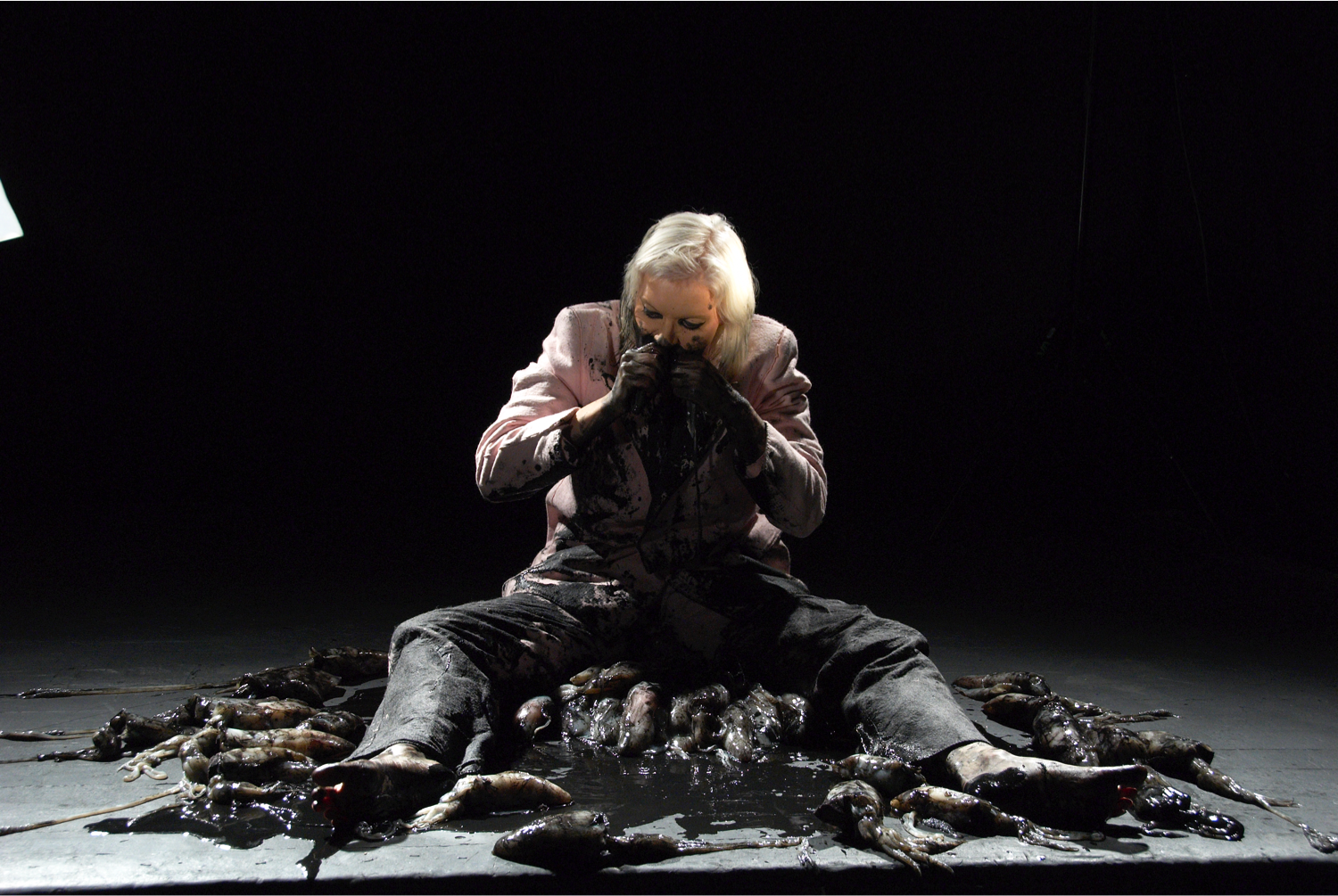
Mike Parr

introduction
First premise: For over two decades art criticism celebrated second-degree representation as the new cool. From the ‘anything goes’ decade of the 1980s to the conceptual remakes of the 2000s the incubator of the art world has remained clean, preserving the white cube of the modernist museum.
-
Category
Performance Art, Liveness -
Published In
In Elspeth Pitt and Roger Butler (eds.), Mike Parr: Language and Chaos, National Gallery of Australia, Canberra, 2016, pp. 70-83. In Synne Genzmer and Lucas Gehrmann (eds), Mike Parr: Edelweiss, Kunsthalle Wien/Verlag für Moderne Kunst Nürnberg, pp. 180-192, 2012. -
Year
2012/16
Mike Parr
Performance, Ontology, Revolt
Second premise: The performative is everywhere. The subject (once the individual) performs endlessly, there is no core identity; people act themselves and change according to context. Jacques Lacan famously said that ‘I is always an Other’ as a way of emphasising that we are only ourselves in relation to an Other, or, more forcefully, we are never ourselves.1 In the endgame of postmodernism there is no truth, nothing is essential—integrity is a form of playacting. This makes way for a society of greed celebrated in the free fall of deregulated capitalism and the collapse of the market.2
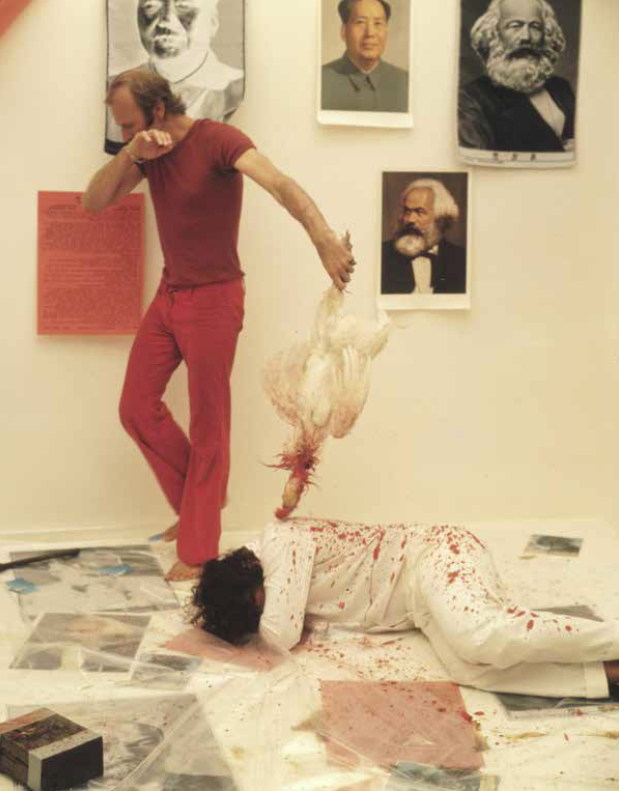 Mike Parr (artist), George Goldberg, Felizitas Stefanitsch (photographers) ‘XX. Identification No. 5 (Totem Murder #1)’, in Rules and Displacement Activities Part II 1975–76, performance photograph
Mike Parr (artist), George Goldberg, Felizitas Stefanitsch (photographers) ‘XX. Identification No. 5 (Totem Murder #1)’, in Rules and Displacement Activities Part II 1975–76, performance photograph
Third premise: The avant-garde is dead. Radical art that seeks to change the world is useless. It’s not worth trying to produce social commentary or cultural political actions because the market is so powerful that it subsumes all resistance. Capitalism feeds off the margins of society and turns gestures of resistance into aesthetic commodities: transgression is institutionalised.3
Where does this leave live art: an art in ‘real time’? What happens to extreme art when art is complicit in a culture of spectacle? Is it possible after postmodernism to create political art?
After the 9/11 terrorist attacks in the USA there appears to have been a turn towards socio-political engagements by artists—well, at least by some artists. This is evident in the shift towards documentary-style video art and the resurgence of performance art. I say this with a degree of trepidation because in Australia the political in art has usually been ignored and marginalised.
Writing in the context of Mike Parr’s Blood Box performance (Artspace, Sydney, 1998) Edward Scheer, reflecting on Australian culture, argued: ‘our bastard cultures need bastard forms’.4 Scheer was writing at 6.00am, 12 hours into a 24-hour endurance piece. The witness scribe for Parr’s performance, Scheer’s statement emerged from a conversation he was having with an audience member about the skills brought to experimental theatre by directors such as Peter Brook. Scheer said then it was a crude point but it presents an interjection that is important in the Australian context where safe art is preferred.
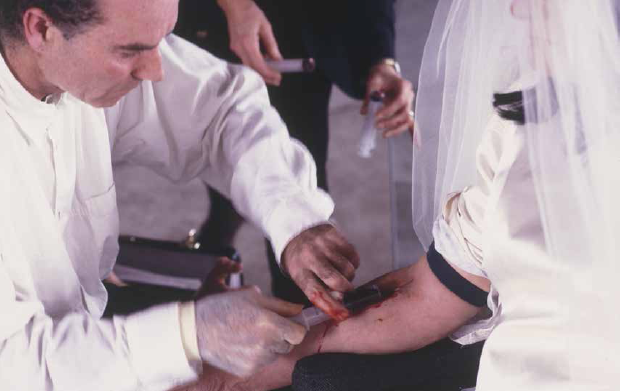 Mike Parr (artist), Paul Green (photographer) Blood Box 1998, photographs
Mike Parr (artist), Paul Green (photographer) Blood Box 1998, photographs
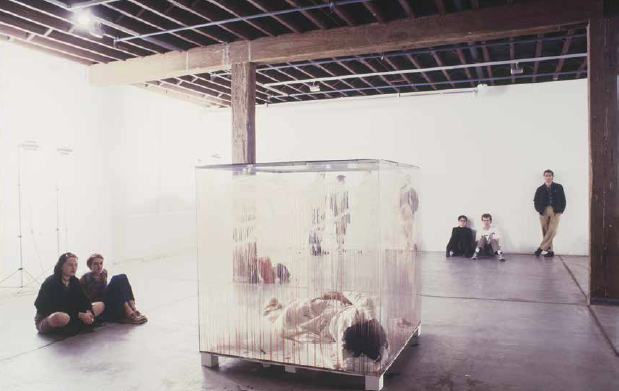 Mike Parr (artist), Paul Green (photographer) Blood Box 1998, photographs
Mike Parr (artist), Paul Green (photographer) Blood Box 1998, photographs
Blood Box: A man enters the space, he’s dressed as a bride, white dress, full regalia. S/he sits on a chair, a medico comes and extracts blood from a vein, it siphons into a plastic medical-like receptacle. The bride is sleep deprived, s/he hasn’t slept for 24 hours, s/he looks tired. S/he enters a glass chamber via a ladder, up and over the top and down the other side, the ladder is extracted, s/he is alone, contained. The collected blood is handed to the bride who squirts it around the glass walls of her cell, creating a red liquid veil that pools in the corners of the enclosure. She lays down, at last to sleep. Visitors come and go, they look into the glass cube, through a screen of blood they see the man-bride sleeping.
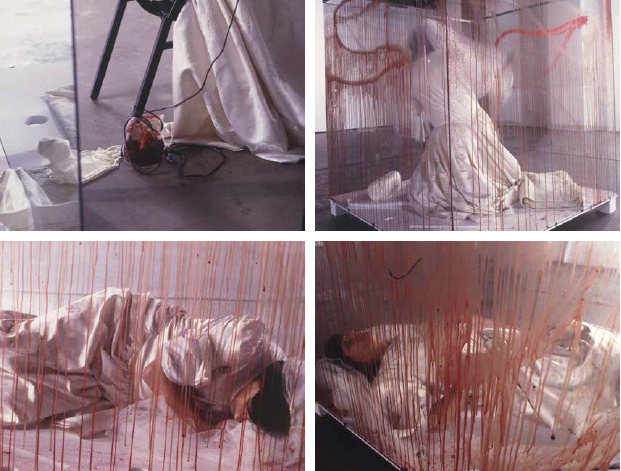 Mike Parr (artist), Paul Green (photographer) Blood Box 1998, photographs
Mike Parr (artist), Paul Green (photographer) Blood Box 1998, photographs
Scheer has pointed out that the bride has enormous significance in most cultures as a figure of ‘magical transformation’; as such she is a liminal figure and ‘the signifier that embodies and guarantees the exchange economy’.5 This economy is fundamental to the continuation of a patriarchal society where woman is the object of exchange. In terms of the ritual structures outlined by Victor Turner, this performance could be considered to move through two of the three stages that he outlines, following Arnold van Gennep’s theory of the Rites of passage.6 Firstly, separation from the social (the solitude of the gallery, the ritual space), and secondly, a marginal or liminal in-between space where the man can transform himself as bride, performing a social abreaction. However, the final stage of reincorporation or return to the normative is not resolved.
Although there are powerful ritual elements in this work, it is unclear to me that there is a resolution. In fact it could be argued that the difference between ritual (at least in its anthropological sense) and performance art actions, which appear ritualistic, is that the latter, by virtue of being an incitement or an injunction, does not seek resolution as such. The aim is to puncture or rupture, to attempt to bring in aspects of the real: the original trauma, which is outside of meaning and a challenge to theory.7 In Lacan’s sense the real confounds any neat binary opposition between the imaginary (images of identity: self, body and other) and the symbolic (language, social law). As Alan Sheridan says: ‘the imaginary falters before the real, and the symbolic stumbles over it’.8 He goes on to say that the term 'the real' is used ‘to describe that which is lacking in the symbolic order, the ineliminable residue of all articulation, the foreclosed element, which may be approached but never grasped: the umbilical cord of the symbolic’.9 It is these aspects and the impossibility of resolution that confound the viewer and make Parr’s work so powerful.
Scheer, who comes from a performance studies background, adopts the language of anthropology and is not afraid to assert a liminal space that he perceives in Parr’s work.10 Conventional art historians would not have read the work in this way. It is refreshing to see the liminal addressed and named. It opens up another discourse, one in which we can situate Parr as a shaman—an abreactor in Claude Levi-Strauss’ terms, someone who straddles psychoanalysis and ritual practice.11 But Parr may well resist such a reading. His impulse is usually political; his assault is on the social and its constructs, its repressions, its hideousness. Although abreaction is certainly a major aspect of his earlier monostructural works, the works from the 1990s and beyond address the social and the political in a more public sense by directly engaging with socio-political issues. This conundrum will always exhaust theory.
Blood Box is presented after the fact as a series of photographs, which document all stages of the performance, and a book with critical essays and a performance diary, written by Scheer who was Parr’s witness scribe throughout the 24 hours of the event. This text is compelling because we see the critic/theorist begin in a fairly objective way, writing what he sees, giving some interpretation, but as the night wears on Scheer enters a more meditative space in his writing, sometimes poetic, sometimes excited, sometimes angry, and we start to listen to a voice that appears at one with the performance. He’s protective of the man-bride, annoyed on her behalf. It is in this context that Scheer has the conversation with an audience member and proclaims that ‘our bastard cultures need bastard forms’.12 It’s an interjection that Parr may well have spoken himself if he was awake. The performance text thus moves from objective to empathetic voice. We hear in Scheer’s voice the endurance and the exhaustion, as well as his reflection on radical art practices and how he contextualises Parr’s work within this genre, as he appears to get increasingly involved in the substance of the work and what it means, ineffable and uncertain as it is.
One of my favourite quotes about body art comes from the Italian critic Germano Celant, who argued that the artists he was engaged with were trying: ‘to insert a subversive element into the tidy, antiseptic and asexual paradise of art’.13 There was a radical edge to this art that sought to destabilise the museum. The modernist white cube with its clean walls and ‘untitled’ modernist/minimalist works was challenged by a generation of body artists who assaulted bourgeois values and dirtied the museum with messy organic materials and bodily fluids. Parr’s body of work from the early 1970s until the present is a dirty and untidy practice that challenges the white cube; over and again he makes reference to these formalist tropes—piercing and probing them and exploding the obscenities behind these ideological structures.
Medium/Structure
Parr is not an artist uninterested in form and structure. On the contrary, he is vigilantly poised to interrogate these structures. His early works and collaborations in film/ performance are exemplary in this regard. Idea Demonstrations 1972 and Rules and Displacement Activities 1973–83 are the equivalent of body art formalism: monostructural works that critique the medium/media in very specific ways.
There are several structural works in Idea Demonstrations—a collaboration with Peter Kennedy (with technical assistance from the filmmakers Aggy Read and Ian Stocks)— that explicitly demonstrate the artist/s experimenting with the medium of video and 16mm film. All the works were made over several days following the exhibition Trans Art 1: Idea Demonstrations in June 1972. The performance sequence was the result of a spontaneous agreement between the artists and filmmakers to present some of Parr’s instruction works as a public event.14 The series is an improvisation and clearly shows the artists bouncing off one another conceptually.
Parr says:
I want to stress this quality of improvisation, because we rapidly moved beyond our respective bodies of work and a work by Peter quickly produced a response from me and vice versa … such as the square taped onto the wall to map the periphery of vision of the lens [the angle of view] [me] and the diagonal tape line which had to be corrected [Peter] or the arm-biting [me] and then Peter’s butterfly clips [on his chest].15
Idea Demonstrations presents some of Parr’s earliest instruction pieces. X The performer should lie on his side on the floor. Holding a microphone to his mouth he should hold his breath … until he is forced to breathe and XXII Sitting before an audience … bare your shoulder. Let a friend bite into your shoulder … until blood appears are endurance works, while XXIV Drip blood from your finger onto the lens of a camera …until the lens is filled with blood plays with the formal qualities of the medium. It is, in my mind, a meditation on colour field painting with a corporeal twist—the blood soaks the lens/screen with a vivid red demonstrating the haptic nature of the medium, relating to the body’s temporality.16 For Parr the extreme actions dramatise the art/life problem but they also extend his interest in ‘factualism’ in that they are ‘independent of a meaningful context’.17 Although critics often want to read these works in a psychological framework, he says: ‘The real point of these works is their pointlessness’.18
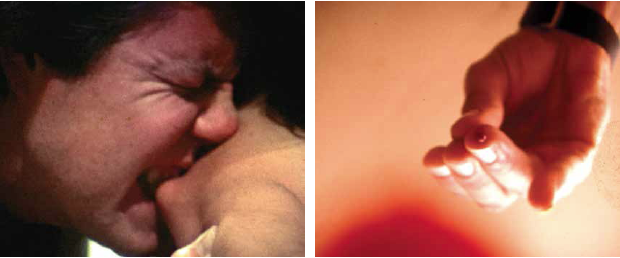 Peter Kennedy / Mike Parr (artists),
Ian Stocks (camera) ‘XXII. Sitting before
an audience … bare your shoulder.
Let a friend bite into your shoulder …
until blood appears’, in Idea Demonstrations
1972, film still
Peter Kennedy / Mike Parr (artists),
Ian Stocks (camera) ‘XXII. Sitting before
an audience … bare your shoulder.
Let a friend bite into your shoulder …
until blood appears’, in Idea Demonstrations
1972, film still
The interrelation of film, video and performance art has been evident throughout Parr’s practice. In 1979 he said ‘time for me is the meaning of performance art’ and, in line with this, he has consistently made provocative and meditative actions and events in which time is a fundamental element.19 Parr embraces time’s enigma through the absent presence of photography, film and video, both within the structure of the work and as an archival mechanism that enables a making of history. In so doing he has consistently engaged with one of the fundamental conundrums of performance art/action—its absent presence after the initial event.
‘Liveness’
The ‘liveness debates’ have troubled theorists and art historians over the last 10 to 15 years. On one hand, Peggy Phelan insists the live event cannot be copied or recorded effectively and that to attempt to do so forecloses on the ontology of performance.20 On the other hand, Amelia Jones argues that we consistently receive performance art through its documentation and to insist that performance should not be recorded would be to shut off access to the medium’s history.21 I find both arguments compelling and I think they both interact with the indexicality of the media that record performance.
Philip Auslander takes this up saying that photo documentation of performance is tied to what he calls the ideology of photography, because the viewer presumes that there is an ‘ontological relationship between performance and document’.22 This is the seduction of the index that Roland Barthes explores in Camera lucida and the ontology of the medium that André Bazin noted many years before.23 There is a conundrum in performance art and its documentation because, as I have argued elsewhere, photography, despite its indexicality, is a performative medium.24 Parr understands this and his images of performance provide complex glimpses of actions that both underline the real and entice multiplicity and fragmentation, emphasising the identity of the subject. Phelan says: ‘performance plunges into visibility—in a maniacally charged present—and disappears into memory, into the realm of invisibility and the unconscious where it eludes regulation and control’.25 I doubt Parr would disagree with this. But Phelan’s position also resonates with Barthes. Laura Mulvey argues that for Barthes: ‘trauma leaves a mark on the unconscious, a kind of index of the psyche that parallels the photograph’s trace of an original event’.26 Invoking Lacan we could say that the photograph is a psychoanalytic medium.27 This is apparent throughout Parr’s photo-documentation—it never appears to me to be a straight capture of the ‘live’, rather the attempt is to present a mediated real: an impossibility, a conundrum, brought about through an orchestrated approach that mines the medium, stretching its possibilities to create an approximation—a sort of tearing at the real.
Body/Politic/Participant
Parr has consistently analysed his role as an artist—specifically the ways in which he relates to his audience as spectator, viewer, participant. Much of his early work in the 1970s experimented with various collaborative models, initially at Inhibodress, with likeminded artists such as Peter Kennedy, and later with his family and friends (Rules and Displacement Activities). There was a utopian edge to this work as he explored ways in which art and artist might shift conventional ways of relating to the public/a community. In more recent works the public (perhaps no longer a community) takes on a darker role.
In Aussie, Aussie, Aussie, Oi, Oi, Oi (Democratic Torture) at Artspace in Sydney (2–3 May 2003) Parr had his face sewn up. Dressed in a black suit with a small replica Australian flag attached to the stump of his left arm, he sat in front of a wall of projections of news reports of the invasion of Iraq.28 After 24 hours Democratic Torture kicked in. Electrodes were attached to the artist’s face and those watching the live webcast were able to administer electric shocks for the remaining six hours of the performance. Parr received so many shocks that the server became overloaded and crashed.29
What is evident in Aussie, Aussie, Aussie, where Parr gives the audience the chance to intervene, is that they are happy to play the part of sadistic torturer and inflict electric shocks on a body already in pain. By the time the audience were able to interact, Parr’s body, which had been motionless for 24 hours, was showing signs of exhaustion and physiological distress. His body was incredibly swollen due to fluid retention so that when he was shocked he shook like jelly.30 Yet the distant audience happily took on the role of the perpetrator and used the artist’s body as a corporeal site to enact atrocities. One might say that the audience is so distracted from the real that they are anaesthetised to the pain of the other.
Parr is clearly an artist who is engaged with the presence—the ontological structure—of performance art, and yet he uses mediation in ways that extend the performance event. In the instances of the webcasts he literally gives his body over to the spectator and in so doing explicates the ways in which this distant relation is compromised. It is a chilling affect as we witness the cruelty of the screen spectator—the anonymous sadist made powerful through distance. Parr’s performance is radical, in itself, but the addition of the cruelty enacted by the distant interloper injects another kind of horror that speaks about the complicity of the community in acts of torture.
Artists are free to experiment in ways that confound scholarship. Parr has consistently engaged analogue and electronic media to extend and interrogate his works. The use of the ‘live’ webcast in Aussie, Aussie, Aussie allowed him to incorporate both the position of the victim (the asylum seeker’s protest: sewing of the lips) and the position of the perpetrator (the inflictors of torture and violence: the anonymous Australian public). This performance confounds academic discourse because it breaks away from binaries. It is both live and mediated, it is not re-mediated as such but it does incorporate the practice of mediation within the performance itself by inviting the distant audience, those watching the webcast, to participate. Those who did participate, by inflicting electric shocks onto Parr’s already distressed body, demonstrated an unmitigated aggression against the other and in so doing (1) underlined the way in which technologies such as the internet allow people to assume anonymous positions within which they can act upon their primal fantasies of aggression and (2) provided evidence that in the greater Australian society there is total disregard for the pain of others. In short these participants played out the role of perpetrator and stood in line with the draconian immigration laws that allow people to be interned and abused.
In Australia, John Howard—the second longest serving Prime Minister (1996–2007) and a key figure in parliament throughout the postmodern period—was famous for inciting the rights of ‘ordinary Australians’ to be ‘relaxed and comfortable’, while he and his government took care of business, including the war on Iraq, draconian industrial relations reforms, shameful immigration policies, which saw many innocent refugees ‘detained’ in prison-like conditions, and the eroding of the human rights of Aboriginal Australians.31 In response to Howard’s immigration policies Parr created Close the Concentration Camps (Monash University Museum of Art, 15 June 2002) as a live performance broadcast via webcast for five hours. The audience and the remote screen viewers saw a man sitting slumped in a chair; he wore a black suit, white shirt and no tie. His right trouser leg was ripped across the thigh revealing the word ‘ALIEN’ branded into his skin.
During the course of the performance the artist’s lips, eyes and ears were sewn together, rough surgical sutures criss-crossed his face, blood and iodine solution ran from the wounds onto his white shirt. Parr could not speak and his vision was impaired. Before him a huge mirror reflected the viewers in the museum; most stood back against the clean white walls, secondary witnesses to the trauma enacted on the artist’s body.
The text along one wall incited Australians to CLOSE THE CONCENTRATION CAMPS. In a separate room excerpts from Not the Hilton: The Immigration Detention Centre Inspection Report of 2000 were projected onto the walls. Parr’s action was an empathetic gesture, in recognition of the trauma experienced by ‘illegal’ immigrants who were, at the time, sewing their lips shut as a protest against their prolonged incarceration.
The audience in the museum heard the burning gas jet and felt the heat of the flame as the artist warmed the branding iron. They smelt the burning flesh when he branded his thigh. If they arrived early enough they watched each suture being sewn into his face by his wife Felizitas. People were free to roam about from one room to the next. They were also free to discuss the performance and to measure their own responses with others, a kind of community formed around the horror enacted by the artist. There was a sense of mourning and disbelief that we could inhabit a country in which such atrocities continue to take place. Everyone shared the nation’s shame.
The webcast experience is different from the live event. Firstly, as the technology currently exists there is a slight delay and a flickering as the live feed catches up with itself. The performer appears to move in slow and jerky movements. Secondly, the aspect of ‘presence’, which has been a grounding principle of much performance art, is challenged, put under eraser by the televisual structure. Adam Geczy argues that this remediation through the screen flattens the live event and ‘the viewer becomes more like a voyeur, protected by distance’.32 This viewer can watch the body in pain and just keep on doing whatever they like: washing dishes, ironing clothes, having sex, eating, drinking or watching another TV screen. In short the viewer can be and often is disengaged.33
The viewer as interloper, as torturer, complicates any reading of ritual, presence and liminal space. All of which can be romanticised in the Western world. Parr is astutely aware of these kinds of slippages. Although he may [or may not] admire the work of Joseph Beuys—the archetypal shaman of Western art—he would not emulate him. Parr is fundamentally a psycho-social artist—an historical materialist who troubles psychoanalysis. This is a powerful and provocative platform that allows him to wrestle with the atrocities of our time while speaking from a personal perspective, analysed as a sort of terror in its own right. Parr does not seek calm equilibrium nor resolution—his aim is to incite action, revulsion, revolt.
The name of the father
Looking at Parr’s opus retrospectively, it certainly has phases, but each and every phase is political. The early monostructural actions, often violent attacks against the artist’s body, critique the psycho-social pathology of patriarchy:
CXXX Drop a brick on your foot. CXII Make a branding iron up with the word artist. Brand this word on your body. LXIV Light a match. Hold your finger in the flame for as long as possible.34
These actions are assaults against the would-be centred subject of patriarchal humanism. This violence is the violence of Antonin Artaud and the performances and installations encompass the notion of a ‘theatre of cruelty’.35 Writing about the performances Black Box: The Theatre of Self Correction parts 1 and 2 (Sydney Biennale and Venice Biennale, respectively) Parr says they are:
Id Spaces, Black Holes, Bermuda Triangles, autistic dilemmas, linguistic double binds, paranoid projections, anuses, throats … more and more the installations underline an absence in order to reveal a presence (a strategic double negative).36
In many ways these early works are actually the most political works, but they are also the most difficult both for the artist and the audience because they are so personal. They are hysteric acts, actions that wound the subject and assault the role of the artist in society.
Writing to Jill Scott in October 1979, about Black Box: The Theatre of Self Correction Part I, Parr says:
Remember the whole drift of my work is to penetrate patriarchal structure in a highly specific way because I attach it to the fact of my disability … in other words I am using my art as a way to get people to look at my disability as well as follow the delights of phylogenetic/metapsychological structures … [It] would be strange for a visual artist to leave something so visual as a missing arm out of his art.37
Parr has consistently engaged with the authoritarian fathers of our recent history. Karl Marx, Joseph Stalin, Mao all appear in various manifestations in the Black Box performances. Like Sigmund Freud and Lacan, Parr knows that the father is dead, absent and missing.38 He may also agree with Slavoj Zizek that ‘in our unconscious, in the real of our desires, we are all murderers’, something that totalitarian leaders have always exploited.39 Parr has also engaged in more personal and intimate analyses of the father by working with his own father during performances. In the film Rules and Displacement Activities Part III 1977–83 the Oedipal relation, its totemic and erotic impetus, is made clear through a sequence of actions and events involving the artist, his family and friends.40 It is a work that is conscious of its own making at the same time that it explores the psychopathology of the family and patriarchy.
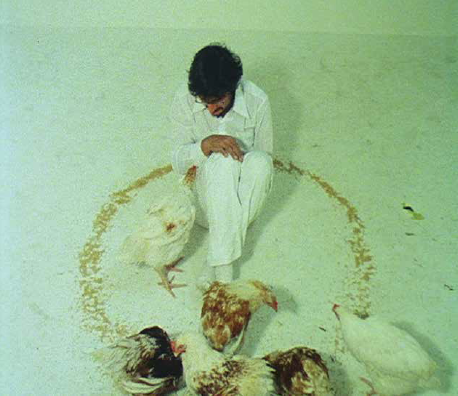 Mike Parr ‘IX. Self Circle of Wheat with
Chickens’, in Rules and Displacement
Activities Part III 1977–83, film still
Mike Parr ‘IX. Self Circle of Wheat with
Chickens’, in Rules and Displacement
Activities Part III 1977–83, film still
The final sequence begins with Self Circle of Wheat with Chickens 1977—Parr sits in a circle demarcated by wheat, five white fowl eat away the circumference and start to peck at the artist’s clothes, presuming him to be the provider. This gentle ritual then cuts to a scene where we see Parr and his father slaughter dozens of roosters. His father cuts off their heads and Parr hangs them upside down on hooks, their wings still flapping and the new wounds spurting blood around the clean white room in which the filming takes place. Another cut, this time to friends and family sitting around the bloodied performance space watching a pornographic film, complete with heavy grunting as the hetero-sex act comes to its climax. The viewers laugh, embarrassed and incredulous. Another cut, back to the chickens, which are now being plucked and washed by two men, some will be divided among the participants to be eaten. And another cut, more like a dissolve—this time to a barren rocky landscape by the Nepean River. It’s dawn and the light is almost white. A lone figure—Parr—meanders across the terrain and uncovers the carcasses of dead roosters, which had been buried under cairns of stones the night before. The soundtrack is a harrowing wind or perhaps the sound of fire. One has the feeling that nature is impending, not tamed; much like the instincts in Freud’s terms, nature resists civilisation. This partial sequence from part III of Rules and Displacement Activities presents the complex story of desire, kinship and social taboo. At all times Parr opens the activity up, encouraging the participants to respond—to intervene within the context of the psychological confrontations that they are experiencing. The sequence I have outlined re-presents the psycho-social trauma of a repressed pathology upon which the social/the civilised resides. Incest, taboo, patricide: violence, tribal affiliation and love are all here, wrapped in a bloody and pornographic bond—troubled and then healed. It is at once a political assault and a ritual. David Bromfield suggests that the viewing of the pornographic film by the family is ‘a symbolic act of incest in opposition to the earlier symbolic patricide’.41
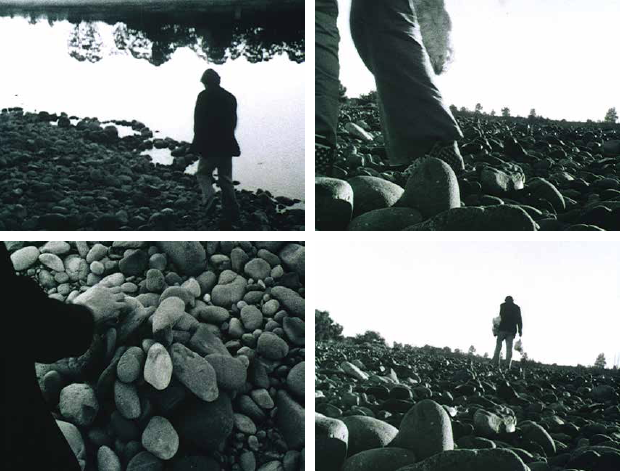 Mike Parr ‘XIII. Burial of Chickens’, in Rules and Displacement Activities Part III 1977–83, film stills
Mike Parr ‘XIII. Burial of Chickens’, in Rules and Displacement Activities Part III 1977–83, film stills
Freud, following Charles Darwin, first described early human society as a horde, ‘ruled over despotically by a powerful male’.42 According to Freud, the development of social organisation begins with totemism—the first religion (a culturally constructed antidote to the reign of the instincts). This is predicated upon the violent killing of the father figure ‘and the transformation of the paternal horde into a community of brothers’.43 Thus patricide is a precursor to civilisation.
While it is evident that Parr deals with the instincts of the group, the family and its psychopathology, he also politicises this. Patricide underpins his work. In Vienna in 2012, as part of a major retrospective of his work at the Kunsthalle museum, Parr was planning to read Adolf Hitler’s Mein Kampf as Bedtime Stories.44 The history of this text needs little introduction in the European context. It is regarded as a hate text and has been banned in the German-speaking world. It is timely to revisit this text and to revisit Freud. Hitler and Freud are both associated with Vienna, and, as the historian Mark Edmundson suggests, both are important for our contemporary situation as we once again encounter fundamentalism.45
Hitler and Freud come together in Freud’s book Group psychology.46 It is as if Freud were speaking to or about Hitler, as the Führer cult rises to power. The first chapter is a summary of Gustave Le Bon’s sociological theory of the behaviour of the crowd. Hitler read about it in a lengthy article in the Nazi party newspaper in 1919 and he adopted the leadership tactics described by Le Bon.47 Hitler became the great orator inciting violence and hypnotising the crowd. Freud noted an erotic connection between the crowd and the despot, explaining that people literally lose their identity and fall in love with the leader/ father. In Le Bon’s words ‘the individual forming part of a group … is no longer himself, but has become an automaton’.48 Hitler said that in his speeches he was making love to the German masses.49
Today we encounter a war against terror, an ‘axis of evil’, a them and us script, in which another scapegoat has been named. Perhaps, without irony, this other is often Semitic— Arab (but not Jewish).
Parr’s performance Bedtime Stories is a radical critique of fascism delivered as a deconstructivist work. Reading the ‘original’ hate text written by Hitler, Parr underlines the contemporary nature of the text.
A man will sleep by day and at night he will sit in a chair. He will read Mein Kampf. The most hated book in Western history—it is a horrible text. Freud would say it is uncivilised.50 Most of it consists of the egotistical ramblings of a despot. It is badly written, it is overly long, and it is narcissistic, but it does what Le Bon and Freud predicted, it incites hatred and violence, it talks to the instinct and gives licence to murder and atrocity.
A man sits in a chair—he reads the hate text, slowly, deliberately. As he reads we will remember that history is not forgotten. The scene: the sleeping and the reading will be projected on screens throughout the city and its environs: placed strategically to connect with a wide-ranging demographic—the city worker, the bourgeois, the working class, the Jewish sector.
In many ways this performance is an action of synthesis. In Parr’s opus, it is situated within the context of many other works stretching from the early 1970s until the present; it says to the viewer—this is a politics that is both personal and broadly historical. What is censored and repressed will rise again until we face it and understand it as part of our psychology. When we take responsibility for this, we take responsibility for history.
A man sits in a chair. He reads in the name-of-the-father. He reads through the fathers of psychoanalysis—uttering the talking cure, he reads us Bedtime Stories. They are horrible, inane, and pathetic by degree—they frighten us because of the repression of the text, because they are an indicator of the violence that is so easily inspired against the Other. So easily seductive: within us.
A man reads at night: a small presence in an isolated space. He reads against fundamentalism. He reads again and again, exhausting himself—he reads to the future, hoping that we will not, ever again, be seduced by the pathological ravings of tyrants.
Endnotes
1. Jacques Lacan. Ecrits: A selection, trans Alan Sheridan. Norton & Company, London and New York, p 23.
2. For a cultural studies analysis see Fredric Jameson, Postmodernism or the cultural logic of late copitaltsm, Duke University Press, Durharn, 1991.
3. These speculations were originally published in my 'Thinking Performance Art', a catalogue essay for Once more with feeling, Margaret Lawrence Gallery, Faculty of the VCA and Music, The University of Melbourne, 23 April - 23 May 2009. curated by Meredith Turnbull.
4. Edward Scheer, 'Mike Parr: Blood Box 6/9/98', in Nicholas Tsoutas (ed), Mike Parr Blood Box, Critical Issues series 10, Artspace Visual Arts Centre, Woolloomooloo, 2006, p 46.
5. Edward Scheer, The infinity machine: Mike Parr's performance art 1971-2005, Schwartz City, Melbourne, 2009, p67.
6. Arnold van Gennep. The rites of passage (1909), trans Monika B Vizedom and Gabrielle L Caffee, The University of Chicago Press, Chicago, 1960.
7. Andrew Brown. 'The Trauma' in Roland Barthes: The figure of writing, Oxford, Lendon, 1992, p 241.
8. As above. p 240. He Is quoting Alan Sheridan. 'Translator's Note', in Jacques Lacan, The four fundamental concepts of psycho-analysis, Penguin Books, 1979, p 280 (first published in French, 1973).
9. Sheridan, p 280.
10. He is drawing on the anthropologist Victor Turner who adopted Arnold van Gennep's concept of the 'liminal phase' witnessed in rites of passage rituals. Van Gennep argued that rites of passage (transitions) 'are marked by three phases: separaton. margin (or limen, signifying 'threshold' in Latin) and aggregation'. Victor Turner, The ritual process: Structure and anti-structure, Aldine Transaction/Transaction Publishers, New Brunswick (USA) and London (UK). p 94.
11. Claude Levi-Strauss. 'The Socerer and his magic', in Structural anhropology, trans Claire Jacobson and Grundfest Schoepf, Penguin Books, 1972, p 181 (first published in French, 1958).
12. Scheer. 'Mike Parr: Blood Box 6/9/98, p 46.
13. Germano Celant, 'Dirty Acconci', Artforum, November, 1980, p 79.
14. Parr and Kennedy had presented a series of similar but different works the year before. These were recorded on 1/4 inch Akai videotape but the Idea Series made in 1972 was recorded on film. For details see Mike Parr Mike Pan performances 1971-2008, Schwartz City, Melbourne, 2008, not paginated.
15. Mike Parr, correspondence with the author, 26 June 2012.
16. Laura Marks. The skin of the film: Intercultural cinema, embodiment and the senses, Duke University Press, Durham and London, 2000, pp 163-5.
17. Mike Parr performances 1971-2008, not paginated.
18. As above.
19. Mike Parr as quoted in Scheer, The infinity machine, p 1.
20. Peggy Phelan. Unmarked: The politics of performance. Routledge. London and New York. 1993, p 146 The passage, which is often quoted, ends: 'To the degree that performance attempts to enter the economy of reproduction, it betrays and lessens the promise of its own ontology.'
21. Amelia Jones, '"Presence" in Absentia: Experiencing Performance as Documentation' Art Journal, 56/4, 1999, p 98.
22. Phhp Auslander. 'The performativity of performance documentation' PAJ 84, (2006) p.1
23. Roland Banes, Camera lucida, Reflections on photography, trans Richard Howard, Fontana, London, 1984 (first published in French, 1980. First English translation published by Hill and Wang, 1981. Andre Bazin. 'The ontology of the performance image', trans Hugh Gray. Film Quarterly, 13:4, Summer 1960, pp 4-9.
24. Anne Marsh, The darkroom: Photography and the theatre of desire, Macmillan, South Yarra, 2003.
25. Phelan, p 148.
26. Laura Mulvey. Death 24x a second: Stillness and the moving image, Reaktion Books, London, 2006, p 65.
27. This has occurred to many historians and theorists of photography. For the most lucid interpretation see Margaret Iversen, 'What is a photograph', Art History. 17:3. September 1994, pp 450-64, See also Brown, 'The Trauma'. Sigmund Freud famously used analogue photographs to explain the workings of the conscious ard unconscious mind, see 'General theory of the neurosis' 1917). The Standard Edition, vol 16, pp 294-5.
28. Parr's left arm was amputated in early childhood.
29. Scheer. The infinity machine, p 129.
30. Parr, in correspondence with the author, 21 May 2012.
31. Member of the House of Representatives 1974-2007. Treasurer in the Fraser Government 1977-1983. Leader of the Opposition 1985-1989.
32. Adam Geczy, 'Mike Parr: Internet performance' Realtime, 52, p 2. at http://www.realtimearts.net/article/52/6946. accessed 5 June 2012.
33. As above.
34. Performance Instructions from 150 Programmes and Investigations 1971-72.
35. See especially, Antonin Artaud 'The theatre or cruelty (First manifesto)', in The theatre and its double, trans Mary Caroline Richards, Grove Press, New York, 1958, pp 89-100.
36. Mike Parr, artist's statement in Presence and absence: Survey of contemporary Australian art no. 1, installation, exhibition catalogue, Art Gallery of Western Australia, Perth, 1983, p 36.
37. As quoted in David Bromfield, Identities: A critical study of the work of Mike Parr, 1970-1990, University of Western Australia Press, Perth, 199, p 180.
38. Jacques Lacan. 'On Creation ex nihilo (1960), in Jacques-Alain Miller (ed) The ethics of psychoanalysis 1959-1960: The seminars of Jacques Lacan, Book VII, trans Dennis Porter. Routledge, London. 1992. pp 126-7 (first publiished In French, 1986).
39 Slavoj Zizek, Looking awry: An introduction to Jacques Lacan through popular culture. MIT Press, Cambridge, Massachusetts, p 16.
40. Rules and Displacement Activities Part III was filmed over a two-week period in July/August 1977 but the ending was not completed until 1983. Scheer therefore suggests that works produced from 1977-1983 can be seen as part of the editorial process. See Scheer, The infinity machine, p 120.
41. Bromfield, p 131.
42. Sigmund Freud, Group psychology and the analysis of the ego (1921), trans James Strachey, Hogarth Press, London, 1967, p 54.
43. As above.
44. The performance was not realised because of legal difficulties.
45. Mark Edmundson, 'The way we live now: Freud and the fundamentalist urge, The New York Times, April 30, 2006. http://www.nytimes.com/2006/04/30/magazine/30wwin_lede.html?_r=1&pagewanted=all. See also Mark Edmundson, The death of Sigmund Freud: Fascism, psychoanalysis and the rise of fundamentalism. Bloomsbury Publishing, London, 2007.
46. Freud, Group psychology.
47. For a lucid analysis see Richard Brockman, 'Freud. Hitler and National Socialism', Psychoanalytic Review, 90:5, October 2003, pp 709-22. Brockman notes that Dr JR Ro6back, a Munich nerve specialist, published an article titled 'The soul of the masses: Psychological reflections on the emergence of popular mass movements', in Volkischer Beabachter. For details see Ian Kershaw, Hitler 1889-1936: Hubris, Allen Lane/Penguin Press, London, 1998, p 652.
48. Le Bon, as quoted by Freud, p 8. For an extended analysis see Gustave Le Bon, The crowd: A study of the popular mind (1895). The Viking Press, New York, 1960.
49. Edmundson, 'The way we live now: Freud and the fundamentalist urge'.
50. Freud, Group psychology. See also The future of on illusion (1927), trans James Strachey, Hogarth Press, London, 1989 art Civilizotion and Its discontents (1930), trans James Strachey. Norton & Co, New York and London, 1961.
